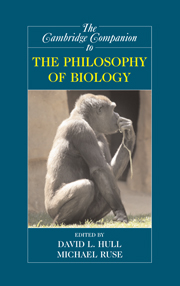Book contents
- Frontmatter
- 1 Adaptation
- 2 Population Genetics
- 3 Units and Levels of Selection
- 4 What’s Wrong with the Emergentist Statistical Interpretation of Natural Selection and Random Drift?
- 5 Gene
- 6 Information in Biology
- 7 Reductionism (and Antireductionism) in Biology
- 8 Mechanisms and Models
- 9 Teleology
- 10 Macroevolution, Minimalism, and the Radiation of the Animals
- 11 Philosophy and Phylogenetics: Historical and Current Connections
- 12 Human Evolution: The Three Grand Challenges of Human Biology
- 13 Varieties of Evolutionary Psychology
- 14 Neurobiology
- 15 Biological Explanations of Human Sexuality: The Genetic Basis of Sexual Orientation
- 16 Game Theory in Evolutionary Biology
- 17 What Is an ‘Embryo’ and How Do We Know?
- 18 Evolutionary Developmental Biology
- 19 Molecular and Systems Biology and Bioethics
- 20 Ecology
- 21 From Ecological Diversity to Biodiversity
- 22 Biology and Religion
- 23 The Moral Grammar of Narratives in History of Biology: The Case of Haeckel and Nazi Biology
- Reference List
- Index
- Series List
4 - What’s Wrong with the Emergentist Statistical Interpretation of Natural Selection and Random Drift?
Published online by Cambridge University Press: 28 April 2008
- Frontmatter
- 1 Adaptation
- 2 Population Genetics
- 3 Units and Levels of Selection
- 4 What’s Wrong with the Emergentist Statistical Interpretation of Natural Selection and Random Drift?
- 5 Gene
- 6 Information in Biology
- 7 Reductionism (and Antireductionism) in Biology
- 8 Mechanisms and Models
- 9 Teleology
- 10 Macroevolution, Minimalism, and the Radiation of the Animals
- 11 Philosophy and Phylogenetics: Historical and Current Connections
- 12 Human Evolution: The Three Grand Challenges of Human Biology
- 13 Varieties of Evolutionary Psychology
- 14 Neurobiology
- 15 Biological Explanations of Human Sexuality: The Genetic Basis of Sexual Orientation
- 16 Game Theory in Evolutionary Biology
- 17 What Is an ‘Embryo’ and How Do We Know?
- 18 Evolutionary Developmental Biology
- 19 Molecular and Systems Biology and Bioethics
- 20 Ecology
- 21 From Ecological Diversity to Biodiversity
- 22 Biology and Religion
- 23 The Moral Grammar of Narratives in History of Biology: The Case of Haeckel and Nazi Biology
- Reference List
- Index
- Series List
Summary
Population-level theories of evolution - the stock and trade of population genetics - are statistical theories par excellence. But what accounts for the statistical character of population-level phenomena? One view is that the population-level statistics are a product of, are generated by, probabilities that attach to the individuals in the population. On this conception, population-level phenomena are explained by individual-level probabilities and their population-level combinations. Another view, which arguably goes back to Fisher (1930) but has been defended recently, is that the population-level statistics are sui generis, that they somehow emerge from the underlying deterministic behavior of the individuals composing the population. Walsh, Lewens, and Ariew (2002) label this the statistical interpretation. We are not willing to give them that term, since everyone will admit that the population-level theories of evolution are statistical, so we will call this the emergentist statistical interpretation (ESI). Our goals are to show that (1) this interpretation is based on gross factual errors concerning the practice of evolutionary biology, concerning both what is done and what can be done; (2) its adoption would entail giving up on most of the explanatory and predictive (i.e., scientific) projects of evolutionary biology; and finally (3) a rival interpretation, which we will label the propensity statistical interpretation (PSI), succeeds exactly where the emergentist interpretation fails.
- Type
- Chapter
- Information
- The Cambridge Companion to the Philosophy of Biology , pp. 66 - 84Publisher: Cambridge University PressPrint publication year: 2007
- 11
- Cited by

